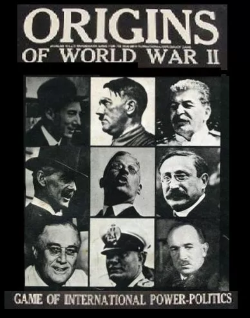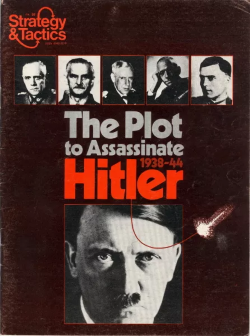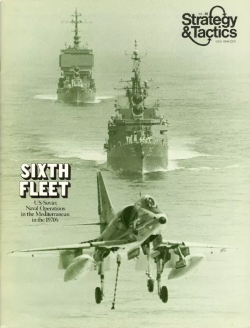
Strategy & Tactics (S&T) is a wargaming magazine now published by Decision Games, notable for publishing a complete new wargame in each issue.

James F. Dunnigan is an author, military-political analyst, Defense and State Department consultant, and wargame designer currently living in New York City.
Simulations Publications, Inc. (SPI) was an American publisher of board wargames and related magazines, particularly its flagship Strategy & Tactics, in the 1970s and early 1980s. It produced an enormous number of games and introduced innovative practices, changing the course of the wargaming hobby in its bid to take control of the hobby away from then-dominant Avalon Hill. SPI ran out of cash in early 1982 when TSR called in a loan secured by SPI's assets. TSR began selling SPI's inventory in 1982, but later acquired the company's trademarks and copyrights in 1983 and continued a form of the operation until 1987.

The Campaign for North Africa (CNA), subtitled "The Desert War, 1940–43", is a strategic "monster" board wargame published by Simulations Publications, Inc. (SPI) in 1978 that simulates the entire North African Campaign of World War II.

Jutland is a naval board wargame published by Avalon Hill in 1967 that simulates the Battle of Jutland in the North Sea during World War I. Upon its release, Jutland was commended for its gameplay and mechanics, but criticism surrounded the complex rules and playing time.

Origins of World War II is a board game published by Avalon Hill in 1971 that combines a wargame with international diplomacy to simulate the diplomatic conditions that led to the outbreak of World War II.

Tactical wargames are a type of wargame that models military conflict at a tactical level, i.e. units range from individual vehicles and squads to platoons or companies. These units are rated based on types and ranges of individual weaponry. The first tactical wargames were played as miniatures, extended to board games, and they are now also enjoyed as video games.

Redmond Aksel Simonsen was an American graphic artist and game designer best known for his work at the board wargame company Simulations Publications, Inc. (SPI) in the 1970s and early 1980s. Simonsen was considered an innovator in game information graphics, and is credited with creating the term "game designer".

A board wargame is a wargame with a set playing surface or board, as opposed to being played on a computer or in a more free-form playing area as in miniatures games. The modern, commercial wargaming hobby developed in 1954 following the publication and commercial success of Tactics. The board wargaming hobby continues to enjoy a sizeable following, with a number of game publishers and gaming conventions dedicated to the hobby both in the English-speaking world and further afield.

A monster game is a game that is either very large, very complex, or both. One criterion sometimes adopted is the number of pieces; a game which puts greater than 1000 counters into play at once may be considered to be a monster game. This classification can technically be applied to any board game, but most commonly refers to the kind of non-abstract wargames in which a large amount of time is needed to play each turn as a result of a relatively high commitment to period accurate military realism. Drang Nach Osten and its companion, Unentschieden led to the Europa Series games, a giant WWII game.

John Frederick Prados was an American author, historian, and wargame designer who specialized in the history of World War II, the Vietnam War, and current international relations.

The American Civil War: 1861–1865 is a board wargame published by Simulations Publications Inc. (SPI) in 1974 that is a strategic simulation of the American Civil War.

The Battles of Bull Run, subtitled "Manassas – June 1861 and August 1862", is a board wargame published by Simulations Publications Inc. (SPI) in 1972 that contains two American Civil War simulations covering the First Battle of Bull Run in 1861, and the Second Battle of Bull Run in 1862.

'CA': Tactical Naval Warfare in the Pacific, 1941-45 is a board wargame published by Simulations Publications Inc. (SPI) in 1973 that simulates surface naval battles during the Pacific Campaign of the Second World War.

MechWar '77, subtitled "Tactical Armored Combat in the 1970s", is a board wargame published by Simulations Publications Inc. (SPI) in 1975 that simulates hypothetical tank combat in the mid-1970s between various adversaries, using the same rules system as the previously published Panzer '44.

Minuteman: The Second American Revolution is a board wargame published by Simulations Publications Inc. (SPI) in 1976 that hypothesizes a modern-day revolution in United States as the result of widespread unrest.

Napoleon at Waterloo is a board wargame published by Simulations Publications Inc. (SPI) in 1971 that simulates the Battle of Waterloo. The game, which features simple rules, was designed as an introduction to board wargaming, and was given as a free gift with each subscription to SPI's Strategy & Tactics magazine.

Frigate: Sea War in the Age of Sail is a board wargame published by Simulations Publications Inc. (SPI) in 1974 that simulates naval combat in the 18th and 19th century Age of Sail.

The Plot to Assassinate Hitler is a board game published by Simulations Publications (SPI) in 1976 that simulates the power struggles in Germany's High Command in the latter years of World War II. The game was the second game in SPI's "Power Politics" series, but did not sell as well as the other games in the series – critic Brian Train referred to it as "the ugly duckling."

Sixth Fleet, subtitled "US/Soviet Naval Warfare in the Mediterranean in the 1970s", is a board wargame published by Simulations Publications Inc. (SPI) in 1975 that simulates a hypothetical attack against NATO forces in the Mediterranean Sea by naval forces of the Soviet Union. The game did not sell well, and several critics found that the tactics used in the game more closely resembled Napoleonic land battles rather than naval warfare in the 1970s.

















